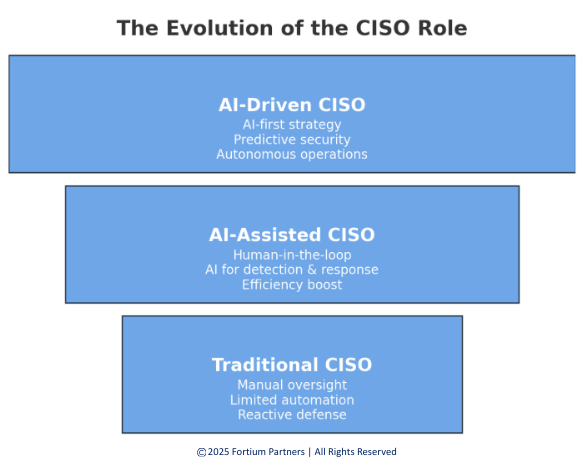>> How AI is redefining the CISO Role...
As business leaders struggle to balance rapid AI adoption with robust security protocols, the Chief Information Security Officer (CISO) sits at the intersection of business strategy, risk management, and cyber defense. Once a purely technical role, the CISO has evolved into a board-level voice, shaping decisions on compliance, resilience, and trust. Yet, as artificial intelligence reshapes every layer of technology, CISOs themselves are experiencing a divide:
- Some still operate without AI,
- Others are assisted by AI, and
- A pioneering group is driven by AI-first strategies.
Your organization’s approach to cybersecurity is now a proxy for its approach to AI itself. As CISOs shift from operating without AI, to being assisted by AI, to being driven by AI-first strategies, CEOs and boards must decide:
-
Are we defending yesterday’s way while adversaries attack with tomorrow’s tools?
-
Do we trust that our human-in-the-loop model balances innovation with accountability?
-
Or are we ready to embed AI at the core of security and risk governance to stay ahead?
The stage your CISO is operating in directly reflects your company’s overall AI maturity.
1. CISOs Without Artificial Intelligence
Many organizations, especially small and mid-sized enterprises, still rely on CISOs who manage cybersecurity without the support of AI tools. These leaders oversee programs built on traditional security information and event management (SIEM) systems, firewalls, endpoint protection, and manual threat analysis.
The advantage of this model is control. Without AI automation, CISOs maintain human oversight of every detection and decision, reducing the risk of “black box” errors. However, the drawbacks are mounting. Threat actors now use AI to craft highly convincing phishing attacks, probe systems at scale, and identify vulnerabilities faster than manual defenses can keep up.
For these CISOs, the pressure is intensifying. Compliance demands like GDPR, HIPAA, and SEC cybersecurity rules require faster incident reporting and evidence of continuous monitoring. The key challenge: without AI-enabled automation, many security teams struggle with alert fatigue, limited staff capacity, and slower response times.
2. CISOs Assisted by Artificial Intelligence
The second category is CISOs who are assisted by AI - leveraging machine learning and automation to augment human decision-making. These leaders deploy AI-enhanced SIEM platforms, anomaly detection models, and natural language processing tools to filter alerts, prioritize incidents, and speed investigations.
In this scenario, AI acts as a force multiplier. For example, AI-driven threat hunting tools can analyze terabytes of log data in seconds and identify patterns invisible to human analysts. Similarly, automated response playbooks allow CISOs to contain threats like credential stuffing or ransomware propagation in near real-time.
More importantly, these CISOs maintain a human-in-the-loop (HITL) approach. AI provides insights, but final risk decisions rest with human judgment. This model balances efficiency with accountability, ensuring that executives and boards retain confidence that critical calls - such as shutting down systems or disclosing breaches - aren’t made solely by algorithms.
3. CISOs Driven by Artificial Intelligence
A small but growing group of security leaders are now driven by AI-first strategies. These CISOs design security programs where AI is not just an assistant but a central operational pillar.
In this model, AI systems proactively predict risks before they materialize. Generative AI builds simulated attack scenarios to test defenses. Large language models continuously monitor regulatory changes and map them to compliance controls. Autonomous security agents patch vulnerabilities, adjust firewall rules, and even negotiate honeypot traps with attackers—all with minimal human intervention.
These AI-driven CISOs focus less on tactical firefighting and more on strategic governance: defining guardrails, ensuring model transparency, and embedding ethical AI use in corporate security culture. They treat AI not just as a tool, but as a co-executive in managing organizational risk.
While promising, this frontier is not without risks. Overreliance on AI can introduce blind spots, supply chain vulnerabilities, or ethical dilemmas around accountability. Still, for organizations operating at global scale, AI-driven security leadership may be the only way to stay ahead of adversaries who are themselves powered by AI.

Conclusion & Call to Action
The CISO role is no longer uniform. Some remain traditional guardians, others are augmented strategists, and a pioneering few are AI-first innovators. Regardless of where they fall, one tenet is clear: in the age of intelligent adversaries, the future of cybersecurity leadership will be inseparable from artificial intelligence.
Where does your organization’s CISO fit today - and where must they be tomorrow?
Fortium Partners helps CEOs and boards ask the right questions to understand your organization’s stage:
-
Without AI: What risks are we accepting by relying solely on manual defenses?
-
Assisted by AI: Are we striking the right balance between speed and human judgment?
-
AI-First: How do we govern AI-driven security while maintaining resilience and trust?
Depending on how you answer, Fortium can help you advance to the next stage—or ensure you remain a leader in the AI-First era of cybersecurity.
__________________________________________________
Contributing author: Tim Mather, Fortium CISO Partner
Cybersecurity Confidence Index
By completing this 2-minute (free) assessment, you’ll receive insights on how to improve confidence in your organization's cybersecurity posture and better align your initiatives for business impact.


